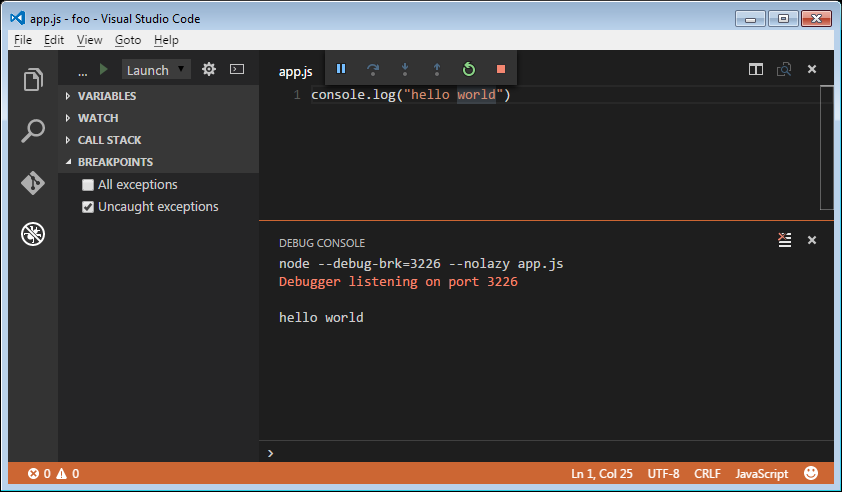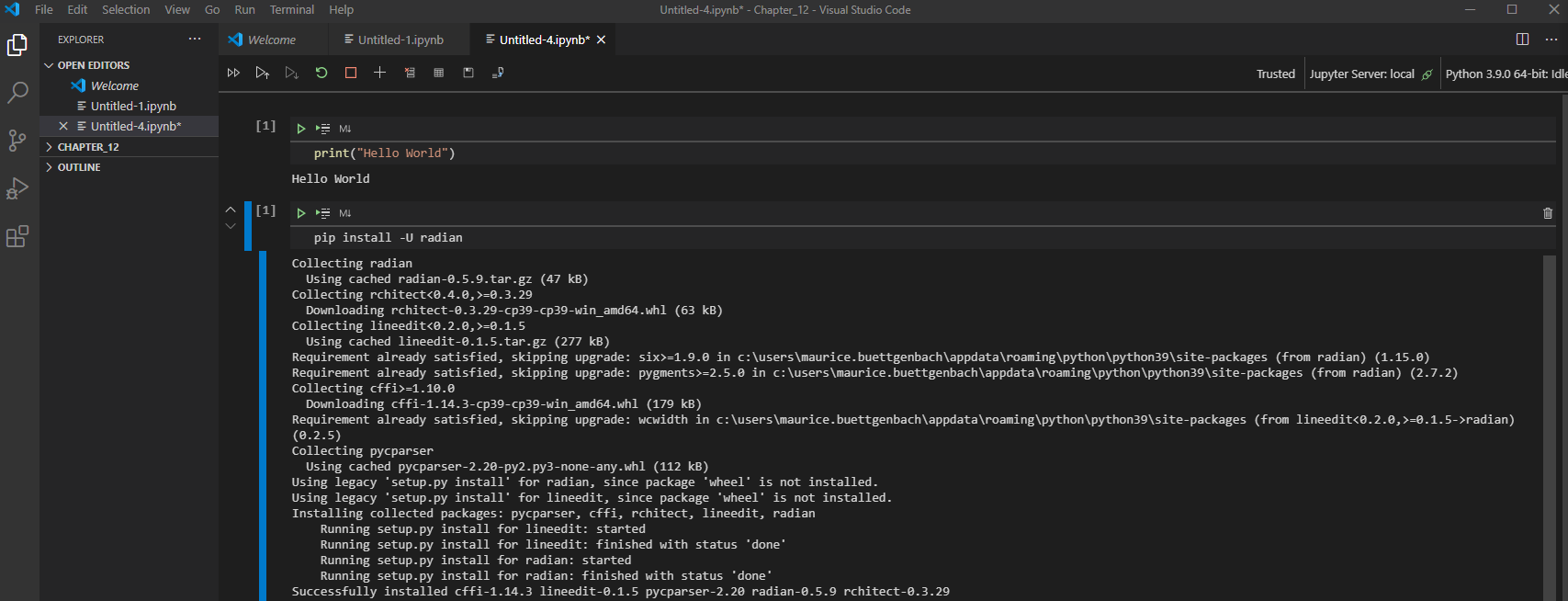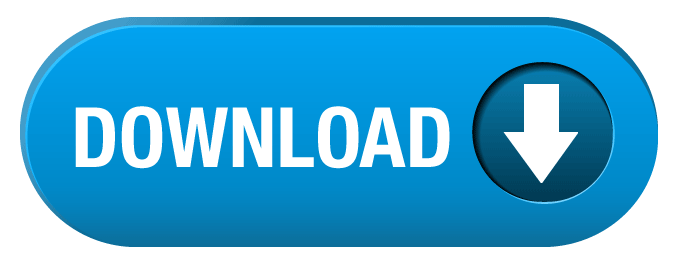Python Importing numpy prevents Visual Studio Code from running 'Hello world' script. I've run into a really bizarre bug using Visual Studio Code with a Python script. I've been using it without any problem for months, but now suddenly the code isn't running when I click the run button in the top right hand corner. I'm not getting any. Hello World # Let's get started by creating the simplest Node.js application, 'Hello World'. Create an empty folder called 'hello', navigate into and open VS Code: mkdir hello cd hello code.
Tutorial
While this tutorial has content that we believe is of great benefit to our community, we have not yet tested or edited it to ensure you have an error-free learning experience. It's on our list, and we're working on it! You can help us out by using the 'report an issue' button at the bottom of the tutorial.

Flutter is a new Open Source framework created by Google that focuses on the creation of cross platform applications. Flutter primarily targets iOS and Android, but is increasingly adding support for desktop platforms too.
In this article, we’re going to investigate Flutter and create our first application.
Flutter apps are built using the Dart programming language. If you’re new to Dart, you may want to start by getting a general overview of the language first.
Installing Flutter
We can install Flutter on our machine in a variety of ways. The easiest way to get started is to download the installer from the Flutter website.
Here’s the setup instructions for:
This article has been written using Flutter 1.2.x.
Plugins
I’d recommend that you either use Android Studio / IntelliJ or Visual Studio Code for your Flutter development. Android Studio offers an integrated, feature-rich IDE with support for Flutter, whereas VSCode offers more lightweight, but functional support.
Android Studio
To install the Flutter plugin for Android Studio, open up the plugin preferences using Preferences > Plugins (macOS) or File > Settings > Plugins (Windows/Linux). How to clear memory in iphone 6. From there, search for the Flutter plugin within the repository list and hit install.
You can find the plugin here.
Visual Studio Code
To install the Flutter plugin for Visual Studio Code, search the store for “Flutter” or click Install from the following page.
Creating a new Flutter project
Assuming that you’ve installed Flutter and have the appropriate dependencies (Android Studio/XCode) installed, we can go ahead and create a new Flutter project.
Once again, this can be done in numerous ways, but I find the easiest ways are to do it via the Terminal or VS Code. Let’s use the terminal in this circumstance:
Launching the project
As anticipated, this will go ahead and create a new Flutter project for us and open it up inside of Visual Studio Code. We can then open this using the Flutter plugin for VS Code.
Hit the “Debug” section of the editor and click “Play” to add a new configuration.
Select “Dart & Flutter” from the dropdown and then choose the editor you’d like to use. I’ve selected the iOS Simulator for this. We should then see our demo application:
Material
We’ve created our first Flutter application and we have it running on an emulator. Let’s take a look at the code that makes this all work. Head to lib/main.dart and you should see the following starter code:
The above code snippet is part of the official Flutter codebase, and available under the following license.
This may seem a little intimidating at first. There’s lots going on. Let’s start with the MyApp widget:
MyApp
We’re firstly importing the Material package from Flutter. This is what gives our application the Material Design look and subsequent access to Material style widgets and functionality.
Then, we’re registering the MyApp widget as the main widget for our application using the runApp method.
Inside of MyApp, we’re returning a build method of type Widget which returns a MaterialApp. The MaterialApp holds metadata such as current ThemeData, the application title, the current home route, and so on.
We don’t have to use MaterialApp here, we could also use the iOS styled CupertinoApp or a custom style with WidgetsApp.
Visual Studio Code Hello World C++
HomePage
Moving on to the HomePage, we can firstly start with the StatefulWidget. This is implemented with the use of two classes, firstly one that defines the widget:
Then, another which contains the State for that widget and the build method. If you’ve ever used React before, this is similar to the render method of JSX.
One of the more important things to consider with the above example is the fact that we’re overriding the createState method to provide our own way of managing state:
The _counter state can therefore be changed with setState(). Next, we define the build method which creates a Scaffold for our application that contains an appBar and a body.
The Scaffold class can be thought of as a top level container when using MaterialApp. This allows us to easily add navigation bars, floating action buttons, drawers, avoid notches, and much more.
Whenever we call setState(), the widget’s build method is also called, thus, updating the view/redrawing with new state. In our example, you can see that we’re making this call to setState within the FloatingActionButton via the onPressed: _incrementCounter function.
Summary
I’d now suggest that you play around with Flutter using this example application. Change the text, do some funky things with the calculations, add a new function, go wild!
Now that we’ve got our environment set up, we can start venturing further into other Flutter topics. I’d be interested in hearing what you’d like to read about!
Now that you’ve set up your development environment, you can create a simple Lightning web component.
Create a Salesforce DX Project
- In Visual Studio Code, open the Command Palette by pressing Ctrl+Shift+P (Windows) or Cmd+Shift+P (macOS).
- Type
SFDX. - Select SFDX: Create Project.
- Press Enter to accept the standard option.
- Enter
HelloWorldLightningWebComponentas the project name. - Press Enter.
- Select a folder to store the project.
- Click Create Project. You should see something like this as your base setup.
Authorize Your Trailhead Playground
- In Visual Studio Code, open the Command Palette by pressing Ctrl+Shift+P (Windows) or Cmd+Shift+P (macOS).
- Type
SFDX. - Select SFDX: Authorize an Org.
- Press Enter to accept the Project Default login URL option.
- Press Enter to accept the default alias.
This opens the Salesforce login in a separate browser window. - Log in using your Trailhead Playground credentials.
- If prompted to allow access, click Allow.
- After you authenticate in the browser, the CLI remembers your credentials. The success message should look like this:
Create a Lightning Web Component
- In Visual Studio Code, open the Command Palette by pressing Ctrl+Shift+P (Windows) or Cmd+Shift+P (macOS).
- Type
SFDX. - Select SFDX: Create Lightning Web Component. Don't use SFDX: Create Lightning Component. (This creates an Aura component.)
- Enter
helloWorldfor the name of the new component. - Press Enter to accept the default
force-app/main/default/lwc. - Press Enter.
- View the newly created files in Visual Studio Code.
- In the HTML file,
helloWorld.html, copy and paste the following code. - Save the file.
- In the JavaScript file,
helloWorld.js, copy and paste the following code. - Save the file.
- In the XML file
helloWorld.js-meta.xml, copy and paste the following code. - Save the file.

Deploy to Your Trailhead Playground
- Right-click the
defaultfolder underforce-app/main. - Click SFDX: Deploy Source to Org.
- In the Output tab of the integrated terminal, view the results of your deployment. You should have also received a notice that states:
SFDX: Deploy Source to Org .. ended with exit code 0. This means that the command ran successfully.
Visual Studio Code C++ Hello World Windows
Add Component to App in Lightning Experience
- In Visual Studio Code, open the Command Palette by pressing Ctrl+Shift+P (Windows) or Cmd+Shift+P (macOS).
- Type
SFDX. - Select SFDX: Open Default Org.
This opens your Trailhead Playground in a separate browser. - From the App Launcher (), find and select Sales.
- Click then select Edit Page.
- Drag the
helloWorldLightning web component from the Custom area of the Lightning Components list to the top of the Page Canvas. - Click Save.
- Click Activate.
- Click Assign as Org Default.
- Click Save.
- Click Save again, then click to return to the page.
- Refresh the page to view your new component.
You’ve officially made your first Lightning web component!
Visual Studio Code Hello World
What’s next?
Visual Studio Code Tutorial
Check out the sample apps on https://trailhead.salesforce.com/sample-gallery. Add more to your helloWorld component, check out the other sample components, and build your own components! As you experiment, use the Component Reference to learn more about how to code Lightning web components.
